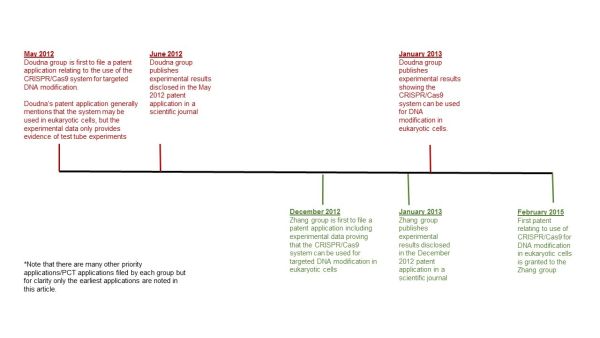The CRISPR/Cas9 system for genome editing has been hailed as the biggest biotech breakthrough of the century – some say equivalent to discovering the structure of DNA or developing PCR. The CRISPR/Cas9 system promises a precise, relatively simple and versatile method for introducing targeted modifications into DNA. Already, investment in this technology has been huge since it has wide applicability in the lab and may even have a role in eradicating genetic disorders in humans and other animals.
The question of who owns and can control the use of the CRISPR/Cas9 system is consequently of pressing importance and is under intense debate. It is claimed to have been developed independently by two separate research groups – both of which sought patent protection and published data from their work creating a complex IP situation, as the patent filing and article publication dates are closely interweaved.
A research group led by Jennifer Doudna at the University of California was the first to file a patent application on the use of this system for targeted DNA modification in May 2012 and the first to publish experimental results reporting in vitro use of a single molecule guide RNA in a CRISPR/Cas9 system for targeted DNA cleavage in June 2012.
Another group, led by Feng Zhang at the Broad Institute of MIT and Harvard, was the first group to publish experimental results showing that this CRISPR/Cas9 system can be used for targeted DNA modification in eukaryotic cells in January 2013, shortly after filing their earliest patent application on this system in December 2012.
After the Zhang group's January 2013 publication, but still in January 2013, the Doudna group also published evidence that the system works in eukaryotic cells.
The Zhang group was, however, the first to obtain a granted US patent after requesting acceleration of the examination process at the US Patent and Trademark Office.

The CRISPR patent wars are being intensely fought in Europe as well as in the US.
A key feature of the US debate is over which research group was the true first inventor of the CRISPR/Cas9 system, especially its use in eukaryotic cells. At the time the first patent applications were filed, the US had a "first-to-invent" system under which the first person to develop a particular invention is entitled to have the patent, even if they were not the first to file a patent application (or the first to get a patent granted) to that invention. The University of California started "interference proceedings" against the Broad Institute in the US to determine who was the first to invent the CRISPR/Cas9 system. The University of California claimed that they were the first to invent the use of the CRISPR/Cas9 system for gene editing, and that their earliest patent application enabled gene editing in eukaryotic cells. In contrast, The Broad Institute argued that the University of California had not invented the use in eukaryotic cells at the time of filing its first patent application and therefore claimed that The Broad Institute were the first to invent the use of CRISPR/Cas9 in eukaryotic cells. The US PTO decided that there was no interference between the two patents, meaning that The Broad Institute's invention is distinct from that of The University of California and therefore The Broad Institute's patents will stand. However, The University of California have appealed this decision with the federal Court of Appeals.
The EPO has announced its intention to grant broad patent claims to The University of California relating to CRISPR gene-editing technology, despite the numerous "third party observations" filed against the patent application. Third part observations are a pre-grant way for third parties to object, sometimes anonymously, to a European patent application. Third party observations most commonly relate to novelty and/or inventive step, but may also relate to clarity, sufficiency of disclosure (whether the application would have provided a person of ordinary skill in the art to perform the invention at its earliest filing date) and unallowable amendments. It can be a good way of getting the EPO to consider certain issues since the EPO should take these observations into account and incorporate any objections they agree with, into its next written communication with the applicant.
In view of the unusually high number of pre-grant third party observations that were filed, we can be sure that when the University of California gets a granted patent it will be the target of multiple strongly fought Oppositions. Oppositions are a post-grant way for third parties to object to the grant of a European patent. It is possible for one party to file both third party observations and an opposition against the same patent. An opposition must be filed within nine months of patent grant and can relate to issues like novelty and inventive step, although the grounds of opposition are slightly restricted compared to those available for third party observations e.g. clarity cannot be objected to. During the opposition procedure, each of the opponents and the patent proprietor get to provide written submissions and the process ends with an oral hearing to argue the case before an Opposition Division consisting of at least three people who will make a decision.
To date, at least seven European patents have been granted to The Broad Institute (Zhang's group) and each of those patents to have reached nine months from grant have attracted multiple oppositions. Oral Proceedings on The Broad Institute's first granted European patent (EP2771468) will be held on 16 January 2018.
One of the principle lines of attack in the opposition proceedings against The Broad Institute's first granted European patent is lack of novelty and/or lack of an inventive step over the University of California's earlier filed first patent application (filed in May 2012) and their June 2012 publication. The decision on novelty will likely come down to a comparison of the precise wording in The Broad Institute's granted patent and the wording in The University of California's first patent application. In relation to inventive step, the Opposition Division at the EPO will have to decide whether it would have been obvious to a person of ordinary skill in the art that the CRISPR/Cas9 system could be applied to eukaryotic cells, in view of The University of California's publication of their in vitro experiments. This can be seen as the mirror image of an argument described above that will be levelled at The University of California.
The Broad Institute is also facing objections on whether their priority claim is valid. In this case, the problem is that the named applicants on The Broad Institute's earliest patent filing in the US were not the same as the applicants named on the later patent filing that became the European patent – which is a requirement. Once again, loss of the priority date would likely be a serious problem.
We can therefore expect the European CRISPR patent wars to continue to be fiercely fought and to continue to include a growing number of patents. Whilst the specific legal challenges used in Europe are different from those in the US, and in particular have highlighted how important a correct, valid priority claim can be, similar scientific arguments are used on both sides of the Atlantic. A huge field of research and potential medical advancement is waiting to see the outcome of these patent wars and, thereafter, how the victors will assert their patent position.
The content of this article is intended to provide a general guide to the subject matter. Specialist advice should be sought about your specific circumstances.

